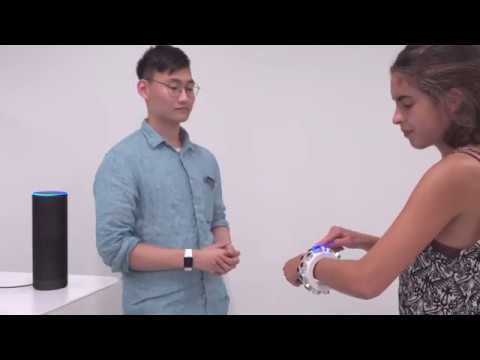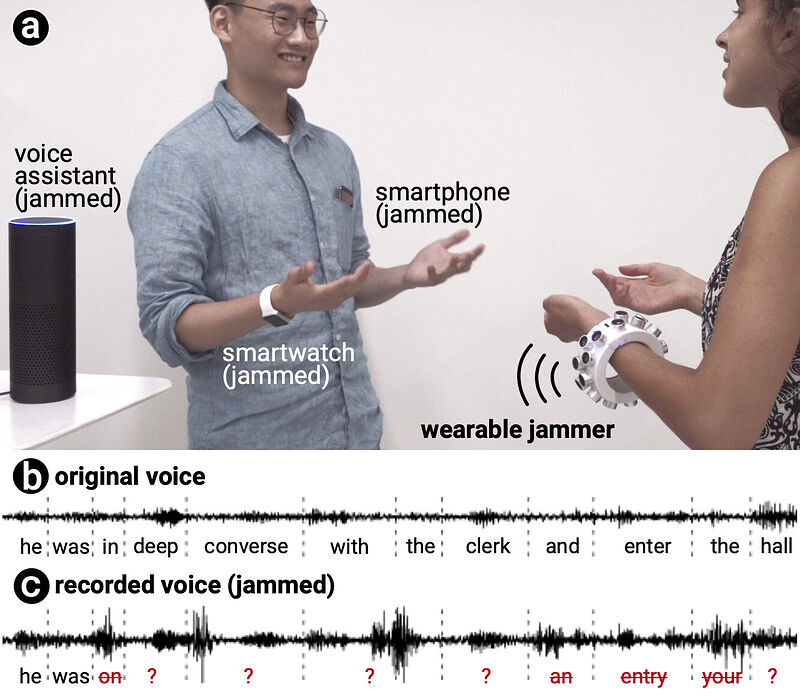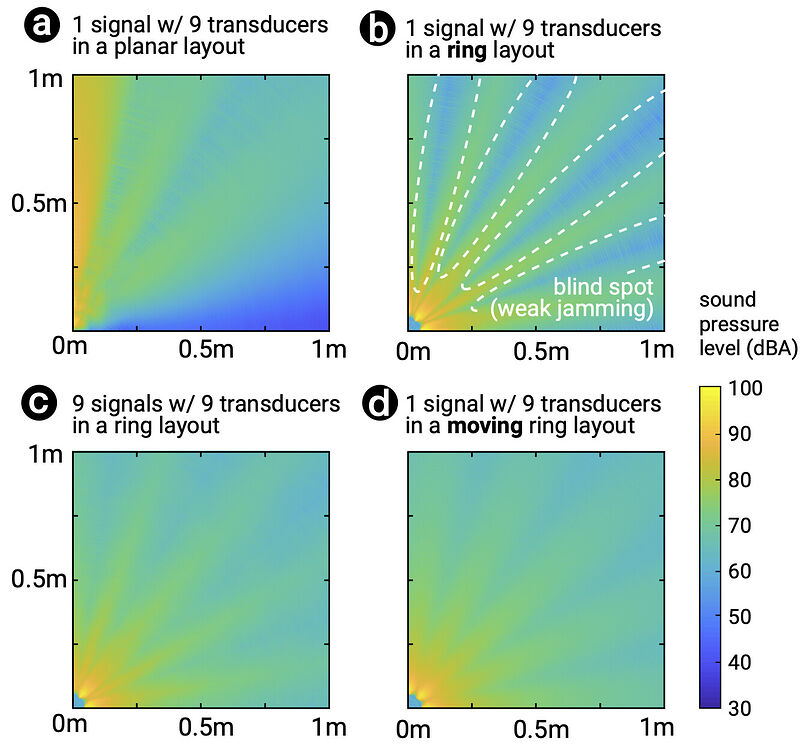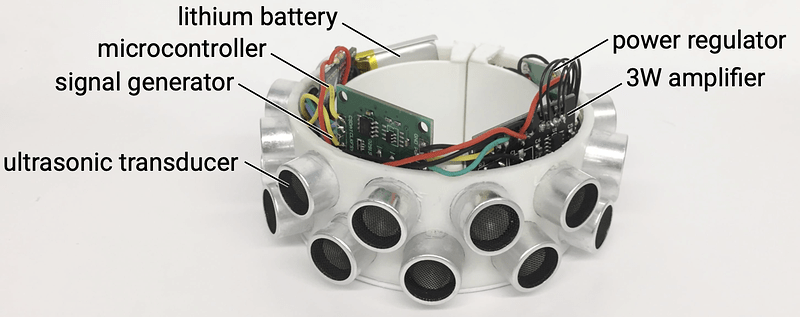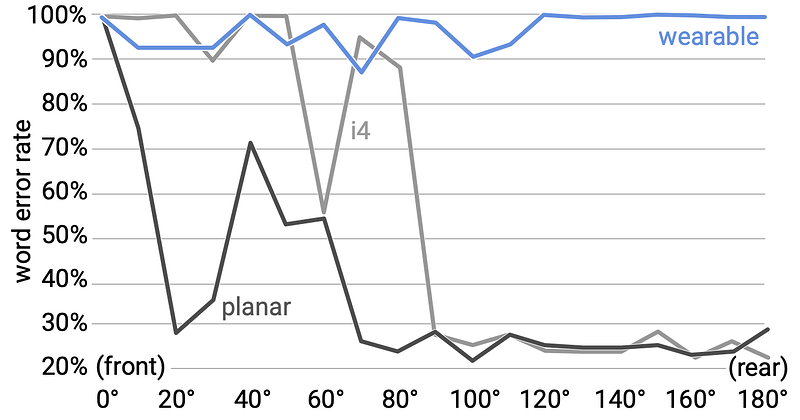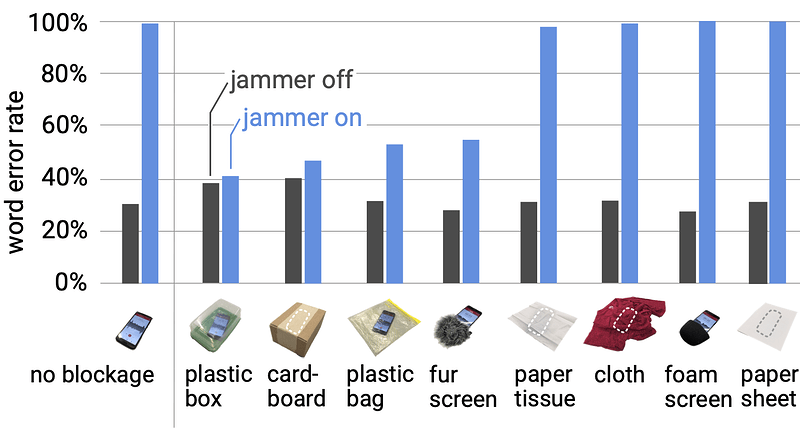We engineered a wearable microphone jammer that is capable of disabling microphones in its user’s surroundings, including hidden microphones. Our device is based on a recent exploit that leverages the fact that when exposed to ultrasonic noise, commodity microphones will leak the noise into the audible range. Moreover, our device exploits a synergy between ultrasonic jamming and the naturally occurring movements that users induce on their wearable devices (e.g., bracelets) as they gesture or walk. We demonstrate that these movements can blur jamming blind spots and increase jamming coverage. Lastly, our wearable bracelet is built in a ring-layout that allows it to jam in multiple directions. This is beneficial in that it allows our jammer to protect against microphones hidden out of sight.
(a) We engineered a wearable ultrasound jammer that can prevent surrounding microphones from eavesdropping on a conversation. (b) This is the actual speech that the conversation partner hears, since our jammer does not disrupt human hearing. However, (c) is the transcript of what a state-of-the-art speech recognizer makes out of the jammed conversation.
Despite the initial excitement around voice-based smart devices, consumers are becoming increasingly nervous with the fact that these interactive devices are, by default, always listening, recording, and possibly saving sensitive personal information. Therefore, it is critical to build tools that protect users against the potential compromise or misuse of microphones in the age of voice-based smart devices.
Recently, researchers have shown that ultrasonic transducers can prevent commodity microphones from recording human speech. While these ultrasonic signals are imperceptible to human ears, they leak into the audible spectrum after being captured by the microphones, producing a jamming signal inside the microphone circuit that jams (disrupts) voice recordings. The leakage is caused by an inherent, nonlinear property of microphone’s hardware.
However, all these devices exhibit two key limitations: (1) They are heavily directional, thus requiring users to point the jammer precisely at the location where the microphones are. This is not only impractical, as it interferes with the users’ primary task, but is also often impossible when microphones are hidden. (2) They rely on multiple transducers that enlarge their jamming coverage but introduce blind spots locations were the signals from two or more transducers cancel each other out. If a microphone is placed in any of these locations it will not be jammed, rendering the whole jammer obsolete.
Our simulations depict how different transducer layouts radiate around the simulated device. We found that, when moving in space, a wearable jammer outperforms stationary jammers.
To tackle these shortcomings, we engineered a wearable jammer that is worn as a bracelet, which is depicted in Figure 1. By turning an ultrasonic jammer into a bracelet, our device leverages natural hand gestures that occur while speaking, gesturing or moving around to blur out the aforementioned blind spots. Furthermore, by arranging the transducers in a ring layout, our wearable jams in multiple directions and protects the privacy of its user’s voice, anywhere and anytime, without requiring its user to manually point the jammer to the eavesdropping microphones.
Our prototype is a self-contained wearable comprised of ultrasonic transducers, a signal generator, a microcontroller, a battery, a voltage regulator and a 3W amplifier.
We confirmed that an ultrasonic microphone jammer is superior to state-of-the-art and commercial stationary jammers by conducting a series of technical evaluations and a user study. These demonstrated that: (1) our wearable jammer outperformed static jammers in jamming coverage; (2) its jamming is effective even if the microphones are hidden and covered by various materials, such as cloths or paper sheets; and, (3) in a life-like situation our study participants felt that our wearable protected the privacy of their voice.
Word error rate (WER) of speech recognition for jamming with our wearable, planar jammer and i4. We found that the WER for planar and i4 dropped drastically after 90 degree, while our wearable maintained a constant jamming effect >87%.
Speech recognition results when the microphone is covered up with various objects.
Publication
Yuxin Chen, Huiying Li, Shan-Yuan Teng, Steven Nagels, Zhijing Li, Pedro Lopes, Ben Y. Zhao, and Haitao Zheng. 2020. Wearable Microphone Jamming. In Proceedings of CHI Conference on Human Factors in Computing Systems 2020 (CHI’2020). https://doi.org/10.1145/3313831.3376304. (Download PDF )
Source Code
Matlab simulation code, Arduino code for signal generator and 3D printing model are available on Github. (code here )
